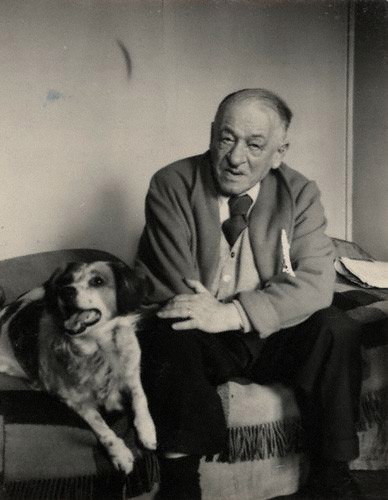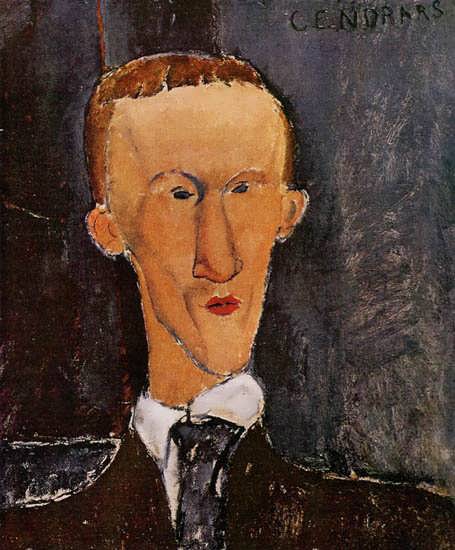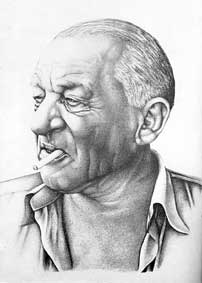<Back to Index>
- Writer Frédéric Louis Sauser (Blaise Cendrars), 1887
PAGE SPONSOR
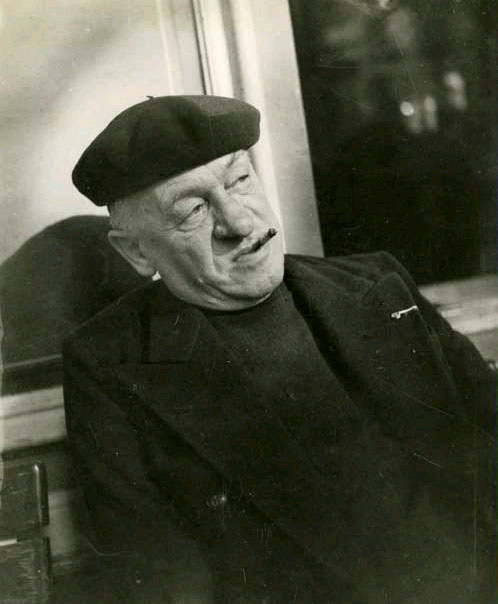
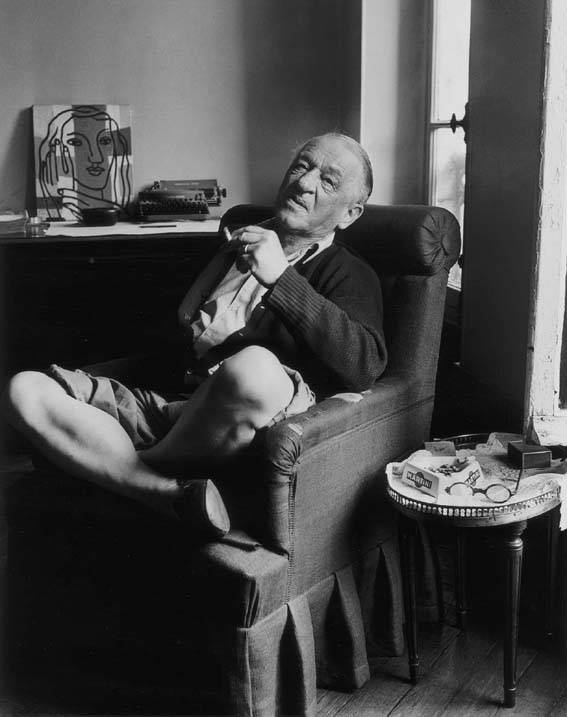
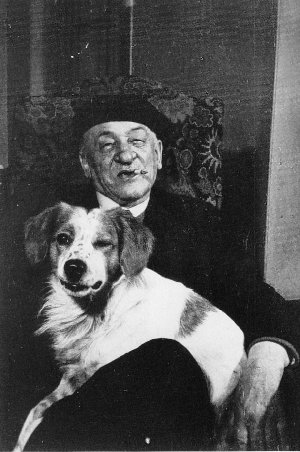
Frédéric Louis Sauser (September 1, 1887 – January 21, 1961), better known as Blaise Cendrars, was a Swiss novelist and poet naturalized French in 1916. He was a writer of considerable influence in the modernist movement.
He was born in La Chaux - de - Fonds, Neuchâtel, Switzerland, to a bourgeois francophone family. Initially, they attempted to send young Frédéric to a German boarding school, but he ran away. After, they tried enrolling him in a school in Neuchâtel, but he had little enthusiasm for his studies. Finally, in 1904, he left school due to poor performance and began an apprenticeship with a Swiss watchmaker in Russia.
It was in St Petersburg that he began to write, thanks to the encouragement of R.R., a librarian at the National Library of Russia. There he wrote the poem La Légende de Novagorode, which R.R. translated into Russian. Supposedly fourteen copies were made, but Cendrars claimed to have no copies of it, and none could be located during his lifetime. In 1995, the Bulgarian poet Kiril Kadiiski claimed to have found one of the Russian translations in Sofia, but the authenticity of the document remains contested.
In 1907, he returned to Switzerland, where he studied medicine at the University of Berne. During this period he wrote his first verified poems, Séquences, influenced by Rémy de Gourmont's Le Latin mystique.
After a short stay in Paris, he traveled to New York, arriving on 11 December 1911. Between 6–8 April 1912 he wrote his long poem, Les Pâques à New York (Easter in New York), his first important contribution to modern literature, signing it (for the first time) with the name Blaise Cendrars.
He returned to Paris in the summer of 1912, now convinced that poetry was his vocation. With Emil Szittya, an anarchist writer, he started the journal Les hommes nouveaux, also the name of the press where he published Les Pâques à New York and Séquences. He became acquainted with Parisian artists and writers such as Chagall, Léger, Survage, Modigliani, Csaky, Archipenko, Jean Hugo and Robert Delaunay. Most notably, he encountered Guillaume Apollinaire. The two poets influenced each other's work. Cendrars' poem Les Pâques à New York influenced Apollinaire's poem Zone. Cendrars' style was based on photographic impressions, themes and reflections in which nostalgia and disillusion were blended with a boundless vision of the world. In 1913, he demonstrated this through his lengthy poem La prose du Transsibérien et de la Petite Jehanne de France (The prose of the Trans - Siberian and of Little Jehanne of France) in which he described his world journey. The work was accompanied by the paintings of Sonia Delaunay - Terk. The long poem, printed on paper two meters in length and folded, he called the first "simultaneous poem". This is important since it was an outgrowth of Robert Delaunay's and others' experiments in proto - abstract expressionism. At the same time Gertrude Stein was beginning to write abstract prose in the manner of Picasso's works. Cendrars liked to claim that the poem's first printing of one hundred fifty copies would, when unfolded, reach the height of the Eiffel Tower.
Cendrars' relationship with painters like Chagall and Léger led him to write a series of revolutionary abstract short poems published in 1919 under the title Dix - neuf poèmes élastiques (Nineteen elastic poems), some being tributes to his fellow artists. In 1954, a collaboration between Cendrars and Léger resulted in Paris, ma ville
(Paris, my city), where author and illustrator together express their
love of the French capital. Owing to Leger's death in 1955, it remained
unpublished until 1987.
His writing career was interrupted by World War I. When it began, he and Italian writer Ricciotto Canudo appealed to other foreign artists to join the French army in battle. He himself joined the French Foreign Legion. He was sent to the front line in the Somme where from mid December 1914 until February 1915 he was in the line at Frise (La Grenouillère and Bois de la Vache). He described this experience in the books La Main coupée (The severed hand) and J'ai tué (I have killed). It was during the bloody attacks in Champagne in September 1915 that Blaise Cendrars lost his right arm and was discharged from the army.
Jean Cocteau introduced him to Eugenia Errázuriz, who proved a supportive, if at times possessive, patron. Around 1918 he visited her house and was so taken with the simplicity of the décor he was inspired to write the poems De Outremer à indigo (From ultramarine to indigo). He stayed with Eugenia in her house in Biarritz, in a room decorated with murals by Pablo Picasso. At this time he was also driving an old Alfa Romeo which had been color - coordinated by Georges Braque. Cendrars became an important part of the era of artistic creativity in Montparnasse at the time, his writings a literary epic of the modern adventurer. He was a friend of Henry Miller who called him his "great idol," a man he "really venerated as a writer." - as well as many of the writers, painters, and sculptors living in Paris. In 1918, his friend Amedeo Modigliani painted his portrait. He was acquainted with Ernest Hemingway, who mentions having seen him "with his broken boxer's nose and his pinned-up empty sleeve, rolling a cigarette with his one good hand," at the Closerie des Lilas in Paris.
After the war, he became involved in the movie industry in Italy, France and the United States. Needing to generate income, after 1925 he stopped publishing poetry and focused on novels and short stories.
During World War II, tragedy struck when his youngest son was killed in an accident while escorting American planes in Morocco. In occupied France, the Gestapo listed Cendrars as a Jewish writer of "French expression."
In 1950, he ended his life of travel by settling down on the rue Jean - Dolent in Paris, across from the La Santé Prison. There he collaborated frequently with Radiodiffusion Française. He finally published again in 1956. The novel, Emmène-moi au bout du monde !…, was to be his last work before suffering a stroke in 1957.
In 1960, André Malraux bestowed upon him the title of Commander of the Légion d'honneur
for his wartime service. A year later, he also received the Paris Grand
Prix for literature. Shortly after, he died. His ashes now rest at Le Tremblay - sur - Mauldre.
